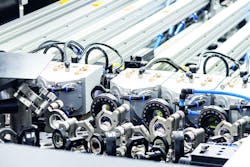Cluster to develop high-power USP lasers for production applications
Ultrashort-pulse (USP) lasers that can process almost any material are characterized by the highest precision during ablation. However, systems currently available do not have enough power to serve many applications with high-throughput requirements.
The Fraunhofer Cluster of Excellence Advanced Photon Sources (CAPS) has set out to change this sustainably. At the Fraunhofer Institute for Laser Technology (Fraunhofer ILT; Aachen, Germany), Hans-Dieter Hoffmann says, "We want to combine the precision of the USP laser with the surface throughput of modern cutting and welding lasers."
For this purpose, Fraunhofer CAPS will initially advance the development of laser sources with the Fraunhofer Institute for Applied Optics and Precision Engineering (Fraunhofer IOF; Jena, Germany), focusing attention on fiber lasers. “We have now reached 3.5 kW and want to scale the system up to 10 kW this year,” says Professor Jens Limpert of Fraunhofer IOF.
Laser source development is only a first step. The institutes in Fraunhofer CAPS are also researching compatible process technology and applications. Partners from science and industry are invited to participate. For them, the cluster acts as a virtual institute in which the experts from the 13 Fraunhofer institutes offer their combined expertise.
Related: Photonics cluster with focus on industrial manufacturing wraps first construction phase
The first application development laboratory in Aachen, being completed with multikilowatt USP lasers, will be inaugurated on September 18, 2019, coinciding with the opening of the Research Center Digital Photonic Production (RCDPP) of RWTH Aachen University. The application laboratory in Jena will open in the fourth quarter of 2019.
In addition to the multikilowatt USP laser sources, jointly developed system technology is available in the application laboratories, where engineers will explore applications in production, imaging, materials, and fundamental science. The goal is to bring together the expertise in the areas of laser sources, process technology, and application in such a way that the partners can create competitive concepts that also fit into the vision of a digitized factory.
The advantages of the new ultrafast lasers are evident in the large-area machining of ultra-hard materials, such as laser processing diamond-composite ceramic pipes for use on the seabed and in photovoltaic or battery manufacturing, where the USP laser can drill and pattern quickly and accurately.
For more information, please visit ilt.fraunhofer.de.
